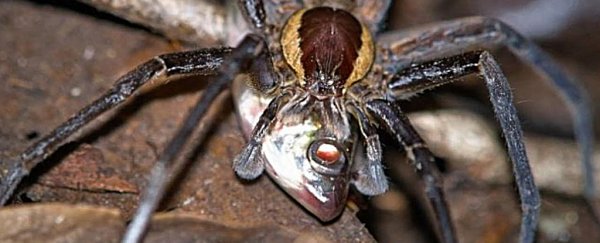Whoa.
After reviewing more than 80 reports of fish predation, researchers from Australia and Switzerland have found that fish-eating is far more widespread in spiders than previously imagined.
Of course, spiders are already known to eat reptiles, mice and even birds and bats. But prior to this, tales of spiders hunting fish in the wild had been anecdotal and isolated to a few different locations.
But after studying all the available literature on the topic, alongside unpublished information from biologists and naturalists, the researchers found the phenomenon occurs pretty much all around the world, and in spider species belonging to eight different taxonomic families.
These semi-aquatic spiders, they found, can all walk on water and swim and dive. Their research is published in PLoS ONE.
 (Alfredo Dosantos Santillan/Ed Germain/Loren Jarvis)
(Alfredo Dosantos Santillan/Ed Germain/Loren Jarvis)
"It's important to gather as much information as you can into one place so that you can put this phenomenon into some context," Bradley Pusey, from the University of Western Australia told Marc Llewellyn over at ABC Science.
Only one of the fish-eating spiders, the diving bell spider, lives under the water. The rest inhabit the edge of water bodies, where they spend most of their time eating insects that are smaller than them, the researchers believe.
But occasionally they'll score one of these fish, which are around 2-6 centimetre in length, on average 2.2 times the size of the spider.
"The spiders that live there are probably hunting for insects most of the time and occasionally, or quite frequently in the case of some families, they are hunting fish," Pusey explained.
"You would think that there was a much higher risk of a spider being damaged in that ensuing conflict, but there's a really significant payoff … it's a big-ticket food item with lots of protein and flesh to consume, whereas an invertebrate has lots of hard material that the spider discards."
Their hunting strategy is actually very sophisticated, and for most of the fish-eating spiders involves waiting on a rock with its three front pairs of legs on the water surface, where they appear to receive information from vibrations on the surface - almost like they're fishing and waiting for a tug.
Once a fish touches one of their legs, they throw themselves into the water, where they kill their prey with a bite to the base of the neck. The spiders then drag the fish back to dry land and inject them with digestive enzymes before eating them, the researchers found.
So we guess if fish are capable of nightmares, this is what they're having them about. Join the club.
Source: ABC Science
